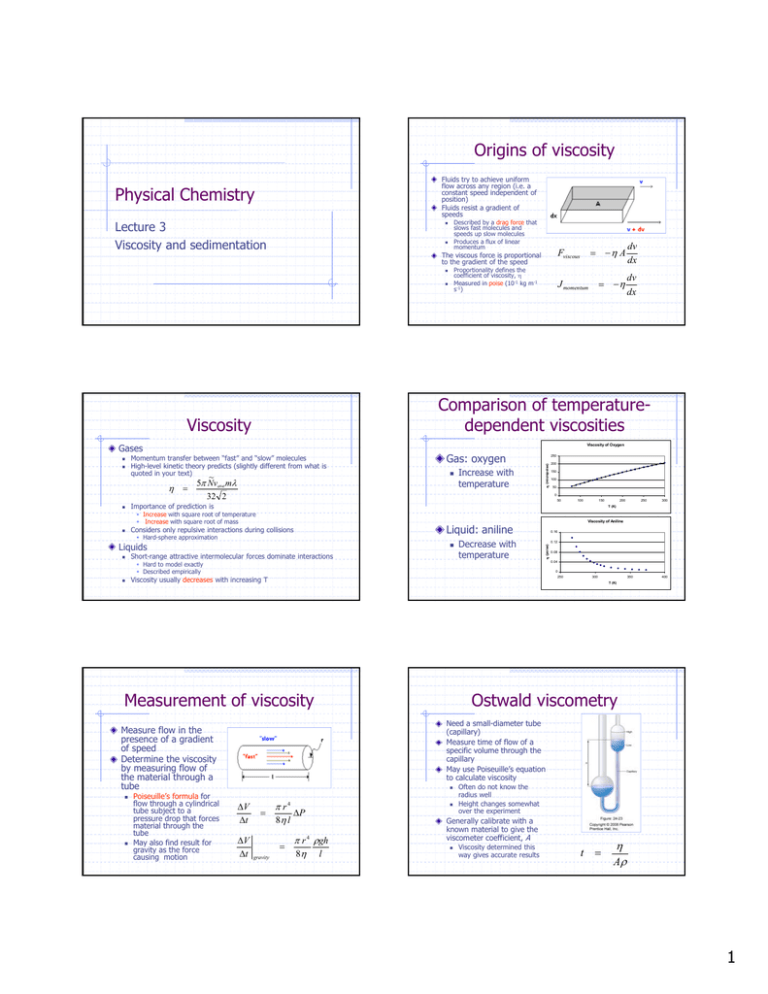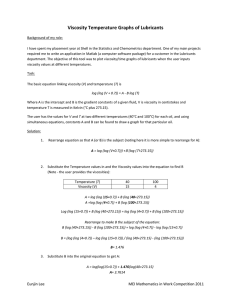Origins of viscosity Physical Chemistry
advertisement

Origins of viscosity Fluids try to achieve uniform flow across any region (i.e. a constant speed independent of position) Fluids resist a gradient of speeds Physical Chemistry Lecture 3 Viscosity and sedimentation Described by a drag force that slows fast molecules and speeds up slow molecules Produces a flux of linear momentum Proportionality defines the coefficient of viscosity, Measured in poise (10-1 kg m-1 s-1) Gases Increase with temperature 50 100 150 200 250 300 Viscosity of Aniline Liquid: aniline Short-range attractive intermolecular forces dominate interactions Decrease with temperature 0.16 0.12 0.08 0.04 0 250 Viscosity usually decreases with increasing T 300 350 400 T (K) Measurement of viscosity Ostwald viscometry Need a small-diameter tube (capillary) Measure time of flow of a specific volume through the capillary May use Poiseuille’s equation to calculate viscosity Measure flow in the presence of a gradient of speed Determine the viscosity by measuring flow of the material through a tube 100 T (K) Considers only repulsive interactions during collisions Poiseuille’s formula for flow through a cylindrical tube subject to a pressure drop that forces material through the tube May also find result for gravity as the force causing motion 150 50 Hard to model exactly Described empirically 200 0 Liquids dv dx 250 Importance of prediction is Hard-sphere approximation Gas: oxygen (micropoise) ~ 5 Nvave m 32 2 Increase with square root of temperature Increase with square root of mass Viscosity of Oxygen Momentum transfer between “fast” and “slow” molecules High-level kinetic theory predicts (slightly different from what is quoted in your text) dv dx J momentum (poise) A Comparison of temperaturedependent viscosities Viscosity Fviscous The viscous force is proportional to the gradient of the speed V t V t r P 8 l 4 gravity r gh 8 l 4 Often do not know the radius well Height changes somewhat over the experiment Generally calibrate with a known material to give the viscometer coefficient, A Viscosity determined this way gives accurate results t A 1 Including excluded-volume effects: Enskøg’s relation Falling-ball viscometer vt R t Simplest kinetic theory g 2 2 r 0 t R 9 Example: viscosity coefficient oxygen viscosity Positive deviation from simple kinetic theory at high T shows effect of attractive forces 1 S 1 T 200 150 100 50 0 8 10 12 14 16 Nature of materials in solution Amount of each material in solution Shape of molecule The shape modifies the proportionality factor Einstein’s relation for viscosity coefficient gives a minimum value of 2.5 Simha factor, , accounts for shape For ellipsoidal molecule, is always larger than for a sphere 300 200 100 0 0 0.005 0.01 0.015 0.02 Number Density (mole cm -3) 2 b0 b0 0.865 V Vm m 0 1 0175 Nature of materials in solution Amount of each material in solution Einstein’s relation for viscosity coefficient of a solution of solid spheres in a continuous medium Viscosity is a measure of V , the volume fraction of the large molecules 0 1 V V 1 0 0 0 1 2.5V 0 0.40 0 V Viscosity of polymer solutions Specific viscosity, sp, from Einstein’s equation linear in concentration General case: solution specific viscosity not linear in concentration Intrinsic viscosity, [] Solution viscosity depends on 18 Square Root of T Viscosity of polymer solutions Gives a density dependence for the viscosity of a gas A virial expansion in the density (i.e. inverse of molar volume) Predicts an increase of gas viscosity with density, as observed experimentally Large molecules in solution with a smallmolecule solvent Viscosity of Oxygen 250 (micropoise) (T ) 0 (T ) 400 Solution viscosity depends on Incorporates attractive forces qualitatively Gives a correction factor 500 Viscosity of polymer solutions Intermolecular interactions are also attractive Approximate interaction potential by Sutherland Viscosity of Nitrogen at 50 C 600 Inclusion of excluded-volume interactions by Enskøg Including attractive forces: Sutherland’s equation Considers molecules as point particles with only collisional effects Predicts no particular density dependence of gas viscosity In agreement with lowdensity measurements (micropoise) Measure the terminal velocity of a ball falling in a fluid Use Stokes Law for the viscous drag to determine viscosity Defined in the infinite-dilution limit Avoids problems such as “entanglement” sp , Einstein sp k1cm 0 0 k 2 cm2 sp lim c c m 0 10 r 3 cm 3m k3cm3 k1 m Mark-Houwink equation Intrinsic viscosity depends on molar mass of a polymer Intrinsic viscosity depends on shape Molar mass determined from this equation is called the viscosity-average molar mass is predicted to be 0.500 for ideal polymer K M 2 Viscosity of polymer solutions Intrinsic solution viscosities Example: polystyrene in benzene Intercept gives intrinsic viscosity One may calculate the viscosity-average molecular weight from [] with the Mark-Houwink equation Shape Protein Globular Ribonuclease 13.7 Serum albumin 67.5 Rod Molar mass (kg mol-1) Random Coil 0.06 sp /cm 0.05 3.410-3 3.710-3 Fibrinogen 330. 2.710-2 Myosin 493. 2.210-1 39,000. 3.710-2 Tobacco mosaic virus Polystyrene in Benzene Intrinsic viscosity (m3 kg-1) Poly--benzyl-L-glutamate 340. 7.210-1 Poly--benzyl-L-glutamate 340. 1.810-1 Ribonuclease 13.6 1.610-2 Serum albumin 67.5 5.210-2 0.04 0.03 0.02 0 5 10 15 20 cm (gm cm -3) Viscosity-determined molecular dimensions Mark-Houwink a constants •Dependence of intrinsic viscosity on molar mass •Coefficient depends on •Polymer Polymer Solvent Polystyrene Benzene, 25C Polystyrene a 0.74 Ideal spherical radius (nm) Maximum-asymmetry prolate ellipsoid ratio 2.66 3.9 Cyclohexane, 34C 0.50 Natural rubber Toluene, 25C 0.67 Ribonuclease 1.93 3.9 Cellulose acetate Acetone, 25C 0.90 Serum albumin 3.37 4.4 Amylose 0.33 N KCl (aq.), 25C 0.50 Hemoglobin 3.4 4.1 Amylose Dimethylsulfoxide, 25C 0.64 Poly--benzyl-L-glutamate Dichloroacetic acid, 25C 0.87 Poly--bezyl-L-glutamate Dimethylformamide, 25C 1.75 Taken from C. Tanford, Physical Chemistry of Macromolecules, John Wiley, New York: 1961. •Solvent Protein -Lactoglobulin Collagen 40 Fibrinogen 11.2 20 Myosin 25.7 68 9.1 29 Tropomyosin •Temperature 175 •Recognizes different structures and shapes Sedimentation Particles settle in a force field based on mass DNA data from Tinoco et al., Physical Chemistry Gravitational settling generally too slow Use centrifugation Measure the settling speed to determine mass Centrifugal motion as the force Unit of s : svedberg = 10-13 sec Time (min) Plot according to equation r ln 2 s t r0 r ln 2 s t r0 Slope gives s , if the frequency is known Frequency in rad/sec r (cm) ln r 16 6.2687 1.836 32 6.3507 1.849 48 6.438 1.862 64 6.5174 1.874 80 6.6047 1.888 96 6.6814 1.899 Sedimentation of a DNA Sample 1.92 y = 0.0008x + 1.8231 R2 = 0.9995 1.9 1.88 ln(r) Sedimentation coefficient 1.86 1.84 1.82 1.8 0 20 40 60 80 100 120 Time (minutes) 3 Molar mass and sedimentation Sedimentation and diffusion are related Summary Movement of molecules under forces Equation gives the ability to find the molar mass from measurements of the diffusion coefficient and the sedimentation coefficient of a solution of macromolecules Viscous flow Sedimentation Useful in characterizing the material M RTs D(1 V2 1 ) Viscosity coefficient is a material property Sedimentation coefficient, S, depends on molar mass 4



